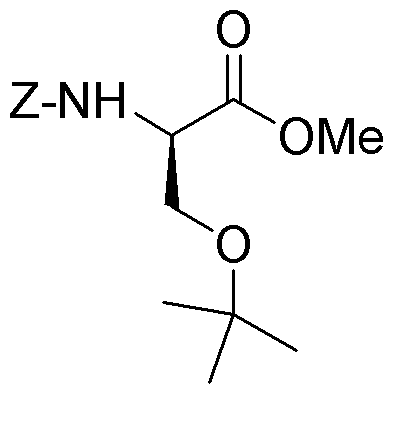Z-O-tert-butyl-D-serine methyl ester is widely utilized in research focused on:
- Peptide Synthesis: This compound serves as a key building block in the synthesis of peptides, particularly in the development of pharmaceuticals. Its stability and reactivity make it an ideal choice for researchers aiming to create complex peptide structures.
- Drug Development: In medicinal chemistry, it is used to modify drug candidates to improve their bioavailability and efficacy. Its unique properties allow for the creation of more effective therapeutic agents.
- Bioconjugation: This chemical is employed in bioconjugation processes to attach biomolecules to surfaces or other molecules, enhancing the functionality of diagnostic tools and drug delivery systems.
- Research in Neuroscience: It plays a role in studies related to neurotransmitter systems, aiding researchers in understanding the effects of amino acid derivatives on neuronal activity and signaling pathways.
- Cosmetic Formulations: The compound is also explored in the cosmetic industry for its potential in formulating skin care products, where it can enhance skin penetration and improve product efficacy.
General Information
Properties
Safety and Regulations
Applications
Z-O-tert-butyl-D-serine methyl ester is widely utilized in research focused on:
- Peptide Synthesis: This compound serves as a key building block in the synthesis of peptides, particularly in the development of pharmaceuticals. Its stability and reactivity make it an ideal choice for researchers aiming to create complex peptide structures.
- Drug Development: In medicinal chemistry, it is used to modify drug candidates to improve their bioavailability and efficacy. Its unique properties allow for the creation of more effective therapeutic agents.
- Bioconjugation: This chemical is employed in bioconjugation processes to attach biomolecules to surfaces or other molecules, enhancing the functionality of diagnostic tools and drug delivery systems.
- Research in Neuroscience: It plays a role in studies related to neurotransmitter systems, aiding researchers in understanding the effects of amino acid derivatives on neuronal activity and signaling pathways.
- Cosmetic Formulations: The compound is also explored in the cosmetic industry for its potential in formulating skin care products, where it can enhance skin penetration and improve product efficacy.
Documents
Safety Data Sheets (SDS)
The SDS provides comprehensive safety information on handling, storage, and disposal of the product.
Product Specification (PS)
The PS provides a comprehensive breakdown of the product’s properties, including chemical composition, physical state, purity, and storage requirements. It also details acceptable quality ranges and the product's intended applications.
Certificates of Analysis (COA)
Search for Certificates of Analysis (COA) by entering the products Lot Number. Lot and Batch Numbers can be found on a product’s label following the words ‘Lot’ or ‘Batch’.
Numéro de catalogue
Numéro de lot/série
Certificates Of Origin (COO)
This COO confirms the country where the product was manufactured, and also details the materials and components used in it and whether it is derived from natural, synthetic, or other specific sources. This certificate may be required for customs, trade, and regulatory compliance.
Numéro de catalogue
Numéro de lot/série
Safety Data Sheets (SDS)
The SDS provides comprehensive safety information on handling, storage, and disposal of the product.
DownloadProduct Specification (PS)
The PS provides a comprehensive breakdown of the product’s properties, including chemical composition, physical state, purity, and storage requirements. It also details acceptable quality ranges and the product's intended applications.
DownloadCertificates of Analysis (COA)
Search for Certificates of Analysis (COA) by entering the products Lot Number. Lot and Batch Numbers can be found on a product’s label following the words ‘Lot’ or ‘Batch’.
Numéro de catalogue
Numéro de lot/série
Certificates Of Origin (COO)
This COO confirms the country where the product was manufactured, and also details the materials and components used in it and whether it is derived from natural, synthetic, or other specific sources. This certificate may be required for customs, trade, and regulatory compliance.


